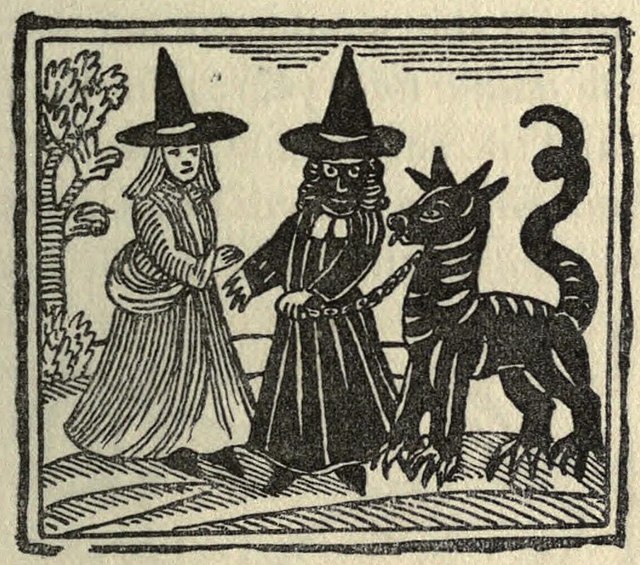by Bryan & Heather
Another October, or, as the kids (including Heather) are calling it these days, “Spooky Season,” has come to an end. In preparation for and celebration of Halloween, we’ve watched a number of appropriately themed movies these past couple months, both cheesy and scary, and the more we watched, the more we noted an interesting trend in the subject matter of our films: there was a veritable bevy of witches. In general, we guess this shouldn’t come as any surprise; witches, and their stereotypes, have long been mainstays of Halloween culture. As students of history living in 2021, however, we couldn’t help but wonder why, especially in light of all the research that has indicated that witches have never been the ones we should really be afraid of.
History tells us that witches have never existed. This is not a statement in denial of the existence of magic, per se, but rather a comment on the driving spirit of witch accusations and trials throughout the centuries. In treating witch culture as an avenue for social and gender inquiry, historians have tapped deep veins of interpretation that persuasively argue that labeling and prosecuting someone as a “witch” has traditionally been a religiously-weighted method of excluding othered people from society and punishing those who do not conform to dominant societal expectations, especially women. Perhaps the best example of this phenomenon, ironically, is Arthur Miller’s fantastic play The Crucible, which intimately demonstrates how accusations could tear a community apart and target the vulnerable and outcast to settle scores and enrich others. Witchcraft tropes have also merged with many of Europe’s oldest anti-Jewish undercurrents such as child sacrifice and livestock poisoning. In other words, witches are the created bogeywomen of the (Christian European) patriarchy.
Thankfully, witches have received something of a rehabilitation over the past half century or so. As early as the 1930s with the “good witch” of The Wizard of Oz, pop culture has begun jettisoning the sinister aspects of witchcraft while retaining the magic and, at times, whimsy inherent in the old stereotypes. The 60s then brought the first full realization of playful witchcraft in the classic sitcom Bewitched. This is likely no coincidence, as the 60s saw both the beginnings of the sexual/cultural revolution and the genesis of modern fantasy through the widespread popularization of J. R. R. Tolkein’s The Lord of the Rings. This trend would continue in ensuing decades with such variations as Sabrina the Teenage Witch, Charmed, and even the rise of wicca as a real-life fringe belief system. Worryingly, though, the old traditions have also survived, sometimes virtually unchanged and to great acclaim. Perhaps the most prominent example of this can be found in 1993’s beloved Hocus Pocus, wherein its Sanderson sisters are every inch the malevolent, malformed stereotype of what a witch should be, even if the film is somewhat of a whimsical holiday film than true horror.
This brings us up to the last decade or so, in which our tastes have matured and we’ve begun paying serious attention to the wide array of entertainment in our favorite genres. Three films in particular have come across our radar in recent months, and they offer intriguingly different takes on the specific subgenre of horror that is witches. 2021’s Fear Street (reviewed here on Concerning History) was a refreshingly historical take, with an innocent woman accused and scapegoated as a witch in historical fashion (though of course with its supernatural elements). 2016’s The Autopsy of Jane Doe, meanwhile, offered an odd amalgam: an innocent woman was accused and executed, but the anti-demon ritual of her death inadvertently summoned a darker power to inhabit her corpse, leading to an eternally rampaging horror in the form of a centuries-dead young woman. Then, of course, there is 2015’s The Witch. An impeccably produced, evocatively atmospheric film set in seventeenth century New England, The Witch reproduces every negative stereotype of witches in the book, from dancing naked in the forest to ailing livestock to bathing in the blood of infants to congress with the devil in the form of a black goat. The main character, innocent of her families’ accusations of witchcraft throughout the film, even then chooses to sign her name in the devil’s book and become a witch at the end of the film, despite all the horrors visited upon her and her family. Even worse, a concluding title card asserts that the film has been synthesized from different historical accounts, and much of the dialogue had been borrowed from them.
It’s clear, then, that the dark misogynistic undercurrents of withcraft accusations remain with us today. Even as recently as six years ago, filmmakers had no problem essentially accepting paranoid patriarchal persecutors’ words at face value and reproducing their accounts as some kind of validated supernatural horror spectacle. Who, though, is still afraid of witches as we enter the third decade of the twenty-first century? It does not bear repeating that sexism is still alive and well, considering many of the recent events in the United States (ahem, Texas) and the behavior of the previous president. We can only hope that we see less films playing into this idea of wicked women in future years and more highlighting the historical horrors of the persecutions leveled against outside cultures and genders from which these stories have arisen.
